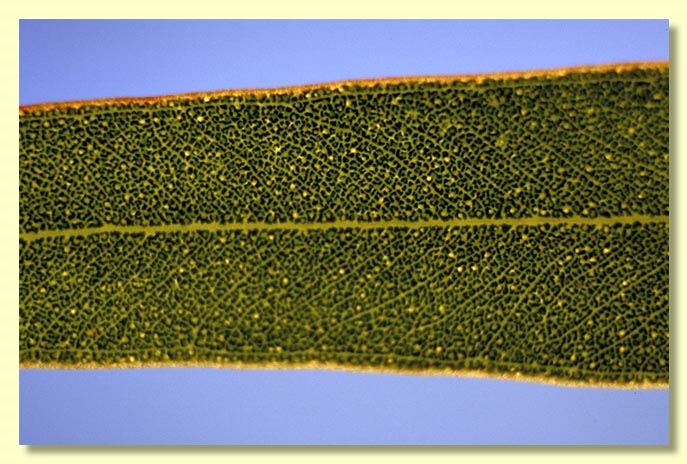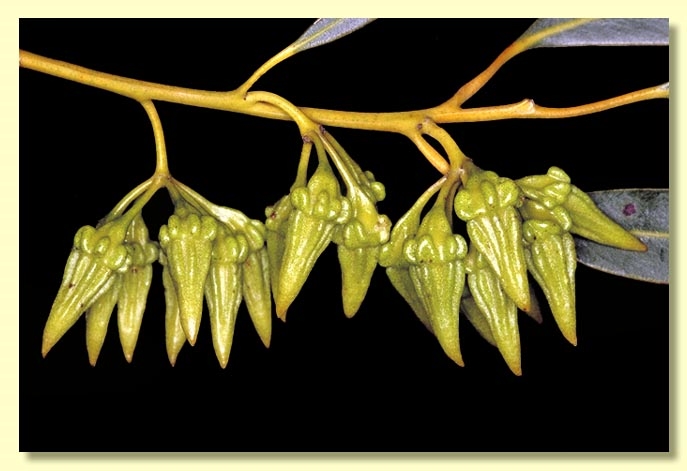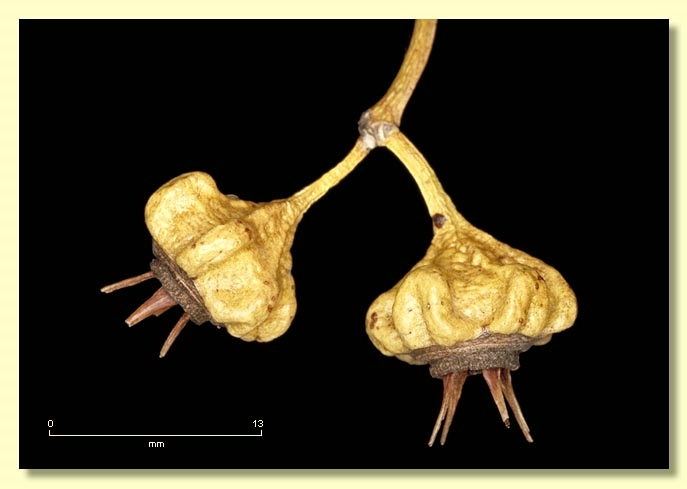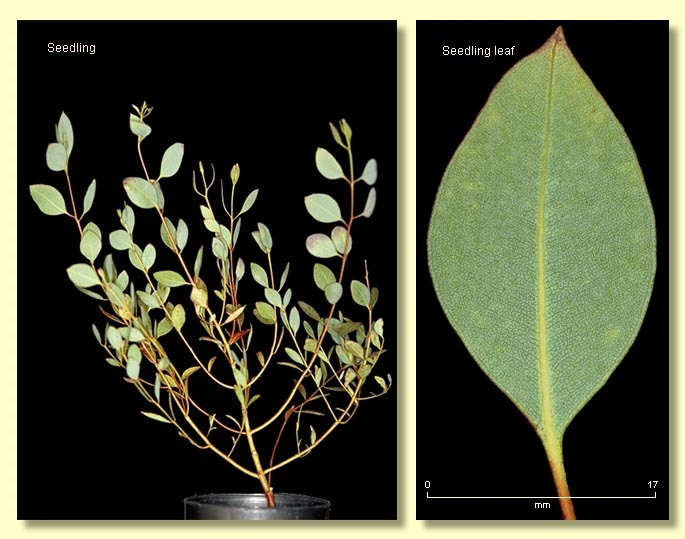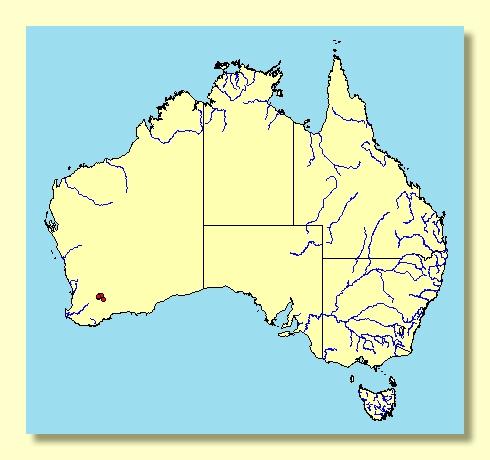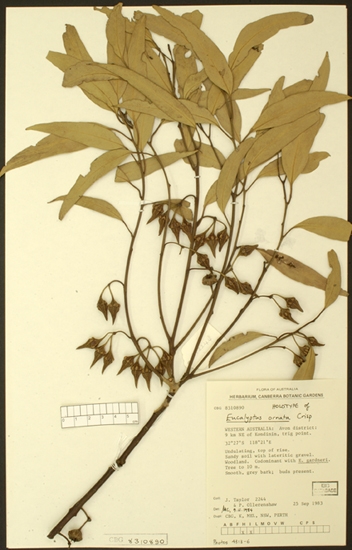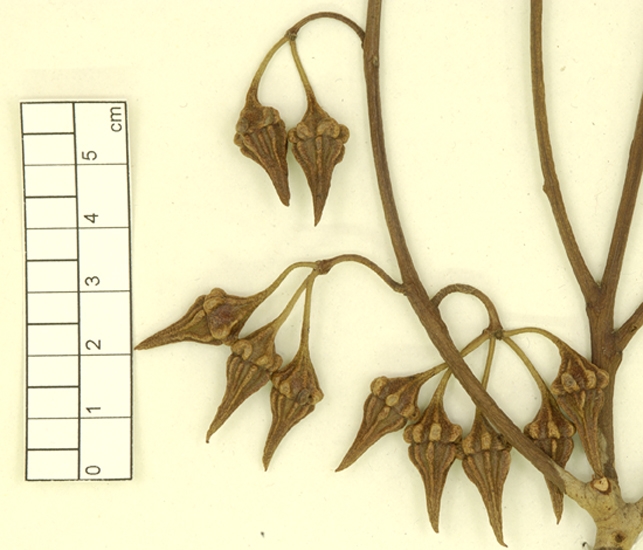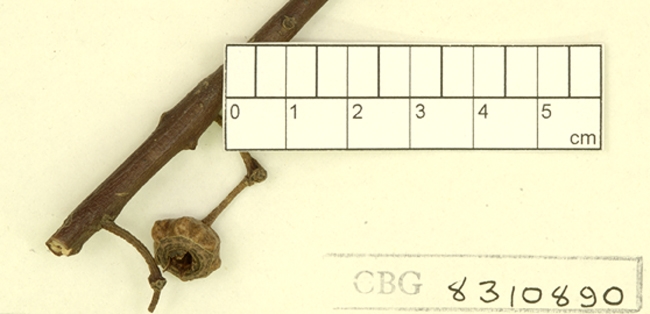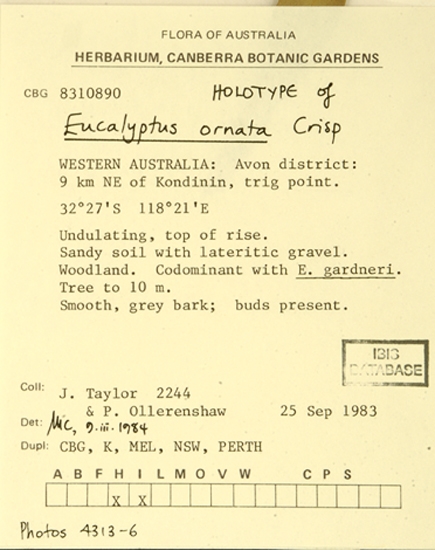Euclid - Online edition
Eucalyptus ornata
Eucalyptus | Symphyomyrtus | Bisectae | Destitutae | Falcatae | Rugatae
Bark smooth throughout, mottled silvery grey and pale pink-grey.
Branchlets lacking oil glands in the pith.
Juvenile growth (coppice or field seedlings to 50 cm): stems rounded in cross-section, non-glaucous; leaves opposite for ca 5 pairs then alternate, always petiolate, ovate to elliptic, 3.5-6 cm long, 1.5-2 cm wide, base tapering to petiole, apex pointed, green to blue-green.
Adult leaves alternate, petioles 1–2.5 cm long; blade lanceolate or sometimes falcate, (6.5)7–12(13) cm long, 1–2 cm wide, base tapering to petiole, margin entire, apex acute, concolorous, glossy, dark green, side-veins acute, reticulation dense to very dense, intramarginal vein very close to margin, oil glands intersectional, numerous, irregular.
Inflorescence axillary unbranched, pendulous, peduncles 1–2(2.8) cm long, buds 9 or 11 per umbel, pedicels 0.7–1 cm long. Mature buds elongated-ovoid with prominent longitudinal ribs on hypanthium and operculum (1.5–2 cm long, 0.6–0.9 cm wide), scar present, operculum narrowly conical, stamens all or mostly inflexed sometimes with a few irregularly flexed, anthers cuboid, versatile, dorsifixed, dehiscing by longitudinal slits, style long and straight, stigma blunt to rounded, locules (3)4, the placentae each with 4 vertical rows of ovules. Flowers creamy white.
Fruit down-turned, pedicellate (pedicels 0.6–1.1 cm long), broadly obconical to hemispherical, prominently ribbed at least on upper part and often extending to base, 0.5–1 cm long, 1–1.7 cm wide (including ribs), disc descending vertically, valves (3)4, prominently exserted and fragile.
Seeds brown to grey-brown, 1–3 mm long, ovoid or flattened-ovoid, dorsal surface very shallowly reticulate and often with two longitudinal furrows, hilum ventral.
Cultivated seedling: cotyledons Y-shaped (bisected); stems rounded to square in cross-section; leaves always petiolate, linear to narrowly elliptical until ca node 7–8 then becoming broadly elliptical, becoming alternate at ca node 10, 2–3.5 cm long, 1.5–2.5 cm wide, green.
Flowering time spring and summer.
A mallet endemic to Western Australia, known only from a few sites north-east and east of Kondinin in the southern wheatbelt. The bark is smooth, grey or silvery and the trunk may be slightly buttressed at the base. The adult leaves are glossy, dark green, buds pendulous and strongy and sharply ribbed from base almost to apex, fruit are flattened-globose and strongly ribbed and juveniles have petiolate leaves.
Within its very restricted natural distribution Eucalyptus ornata is unlikely to be confused with any other species.
Further to the east and north-west and south other similarly smooth-barked mallet species closely related to E. ornata occur: E. rugulata, found in the Hatter Hill to South Ironcap area east of Varley, has more obese buds, with pronounced but shallow ribbing on the hypanthium only, and longer, ribbed fruit; E. falcata, found sporadically from Wickepin to Tammin and south to Jerramungup and Lake King, has similarly sized buds to E. ornata but are only slightly ribbed on the base and has scarcely ribbed or smooth fruit; E. recta, which is very restricted in the central wheatbelt near Cadoux, has completely smooth (un-ribbed) buds and fruit; and E. purpurata, restricted to near Bandalup Hill, which has smaller basally ribbed buds and smaller, smooth fruit. The newly described mallet E. annettae differs profoundly in its glaucous branchlets, larger adult leaves short conical opercukum and ribbed buds and fruit, and is found only near Israelite Bay. Another similar species, E. dorrienii, widespread in wheatbelt and adjacent foothills, differs in being a mallee and has similar but much less prominently ribbed buds and fruit similar in size to those of E. ornata.
In the classification of Brooker (2000) E. ornata belongs in Eucalyptus subgenus Symphyomyrtus section Bisectae subsection Destitutae because buds have two opercula, cotyledons are Y-shaped and branchlets lack oil glands in the pith. Within this sub-subsection E. ornata belongs to a group of mallet and mallee species characterised by often pendulous inflorescences with pedicellate ovoid buds with a conical to beaked operculum, flattened-globose fruits with exserted fragile valves and adult leaves that are green, densely reticulate and have numerous intersectional oil glands and smooth bark. The species are the mallets E. falcata, E. ornata, E. purpurata, E. recta, E. rugulata and the recently described E. annettae; and the mallees E. dorrienii, E. petrensis, E. ecostata and the newly described E. opimiflora, plus the coastal and sub-coastal mallees E. goniantha (with two subspecies), E. kessellii (with two subspecies), E. notactites and E. semiglobosa. These mallets and mallees together form series Falcatae subseries Rugatae, albeit in a form somewhat modified from Brooker's classification.



